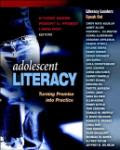This chapter resonated deeply with me. In my current position in alternative education I am both a teacher and an on-site administrator, and in this capacity I spend a lot of time talking with student one-on-one addressing numerous issues. I have had the experience Chris Crutcher writes of -- a deeply troubled teenager who fondly recalls his grade three teacher. Their relationship is so strong, they meet periodically over coffee. When my student speaks of his former teacher, he glows. It is one of the few positive and deeply meaningful relationships he has, and it clearly speaks to the connections that are possible.
Crutcher's inclusion of stats. on page 16 -- one in three girls sexually mistreated, etc. -- is so powerful in illustrating every teachers role in working with adolescents facing huge challenges and makes us realize how critical our relationship with all our students can be. The potential there is very exciting and for many, the reason they were drawn to becoming educators -- it's the possibility to make a positive difference in people's lives. I have learned you will be remarkably successful with some, less so with others, but you never stop trying. His statement that real education consists of "response, expression, relationship" makes me think of the character development program we are currently building in our board. As the character development teacher in my program, I plan on sharing this article with my colleagues.
Wednesday, August 13, 2008
Subscribe to:
Post Comments (Atom)

2 comments:
Research has shown that a student's achievement and success in school is directly related to what classroom teachers do - in fact the classroom teacher is the key to student achievement. One of the strongest strategies is make sure that teachers have a connection with his/her students - that the student knows he/she has a voice with one caring adult. That relationship is key to keeping the student in school. This is why I have always felt that the larger the school, the more difficult it is to make sure every student has that relationship. It's not to say that it can't be done in a larger school but just more difficult to prevent someone from falling through the cracks.
I totally agree that the relationship between classroom teacher and student is often the key to success. Kids need to feel that we're on their side, otherwise we can be met with skepticism at best and complete opposition at worst.
In this chapter, the lines that really struck a chord with me are: "Tears ran down her cheeks like raindrops on a rainy window as she talked, and when I looked at the teacher standing beside her, her hand tucked just inside the girl's elbow, those same tears ran down her cheeks. The girl saw her teacher's reaction and leaned into her as if falling into an elegant hammock" (p. 17).
Besides simply appreciating the beautiful imagery here, I connected with these lines because they reminded me of that intense feeling we've all had- where we feel what our students feel- and that beautiful, sometimes sorrowful empathy, is important- because it shows that we are engaging fully with our kids. It also shows how key our role is- that we are a source of support- sometimes the only one in a student's life.
I find that once I establish a trust level, where my students can see that I am the "caring adult", the learning progression becomes so much easier because the walls have come down.
So, although our strategies are important, it's crucial to have this type of rapport- and I do agree with Sharon that it's probably easier in smaller schools (and with smaller class sizes).
:)
Natalie
Post a Comment